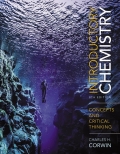
Concept explainers
(a)
Interpretation:
Whether the saturated fatty acid typifies as a fat, an oil, or both is to be stated.
Concept introduction:
A lipid is a compound which is made up of an alcohol and one or more carboxylic acids. Lipids are found in fats and vegetable oils. Fats and oil are formed by the esters of glycerol. Fatty acids are the triglycerides formed from the reaction between three long chain carboxylic acids and glycerol joined by three ester linkages.
(b)
Interpretation:
Whether the unsaturated fatty acid typifies as a fat, an oil, or both is to be stated.
Concept introduction:
A lipid is a compound which is made up of an alcohol and one or more carboxylic acids. Lipids are found in fats and vegetable oils. Fats and oil are formed by the esters of glycerol. Fatty acids are the triglycerides formed from the reaction between three long chain carboxylic acids and glycerol joined by three ester linkages.
(c)
Interpretation:
Whether glycerol typifies as a fat, an oil, or both is to be stated.
Concept introduction:
A lipid is a compound which is made up of an alcohol and one or more carboxylic acids. Lipids are found in fats and vegetable oils. Fats and oil are formed by the esters of glycerol. Fatty acids are the triglycerides formed from the reaction between three long chain carboxylic acids and glycerol joined by three ester linkages.
(d)
Interpretation:
Whether ester linkage typifies as a fat, an oil, or both is to be stated.
Concept introduction:
A lipid is a compound which is made up of an alcohol and one or more carboxylic acids. Lipids are found in fats and vegetable oils. Fats and oil are formed by the esters of glycerol. Fatty acids are the triglycerides formed from the reaction between three long chain carboxylic acids and glycerol joined by three ester linkages.
Want to see the full answer?
Check out a sample textbook solution
Chapter 20 Solutions
EBK INTRODUCTORY CHEMISTRY
- Calculate the pH and the pOH of each of the following solutions at 25 °C for which the substances ionize completely: (a) 0.000259 M HClO4arrow_forwardWhat is the pH of a 1.0 L buffer made with 0.300 mol of HF (Ka = 6.8 × 10⁻⁴) and 0.200 mol of NaF to which 0.160 mol of NaOH were added?arrow_forwardDetermine if the following salt is neutral, acidic or basic. If acidic or basic, write the appropriate equilibrium equation for the acid or base that exists when the salt is dissolved in aqueous solution. If neutral, simply write only NR. Be sure to include the proper phases for all species within the reaction. NaN₃arrow_forward
- A. Draw the structure of each of the following alcohols. Then draw and name the product you would expect to produce by the oxidation of each. a. 4-Methyl-2-heptanol b. 3,4-Dimethyl-1-pentanol c. 4-Ethyl-2-heptanol d. 5,7-Dichloro-3-heptanolarrow_forwardWhat is the pH of a 1.0 L buffer made with 0.300 mol of HF (Ka = 6.8 × 10⁻⁴) and 0.200 mol of NaF to which 0.160 mol of NaOH were added?arrow_forwardCan I please get help with this.arrow_forward
- Determine if the following salt is neutral, acidic or basic. If acidic or basic, write the appropriate equilibrium equation for the acid or base that exists when the salt is dissolved in aqueous solution. If neutral, simply write only NR. Be sure to include the proper phases for all species within the reaction. N₂H₅ClO₄arrow_forwardPlease help me with identifying these.arrow_forwardCan I please get help with this?arrow_forward
 Chemistry for Today: General, Organic, and Bioche...ChemistryISBN:9781305960060Author:Spencer L. Seager, Michael R. Slabaugh, Maren S. HansenPublisher:Cengage Learning
Chemistry for Today: General, Organic, and Bioche...ChemistryISBN:9781305960060Author:Spencer L. Seager, Michael R. Slabaugh, Maren S. HansenPublisher:Cengage Learning Introductory Chemistry: An Active Learning Approa...ChemistryISBN:9781305079250Author:Mark S. Cracolice, Ed PetersPublisher:Cengage Learning
Introductory Chemistry: An Active Learning Approa...ChemistryISBN:9781305079250Author:Mark S. Cracolice, Ed PetersPublisher:Cengage Learning Organic ChemistryChemistryISBN:9781305580350Author:William H. Brown, Brent L. Iverson, Eric Anslyn, Christopher S. FootePublisher:Cengage Learning
Organic ChemistryChemistryISBN:9781305580350Author:William H. Brown, Brent L. Iverson, Eric Anslyn, Christopher S. FootePublisher:Cengage Learning
 World of Chemistry, 3rd editionChemistryISBN:9781133109655Author:Steven S. Zumdahl, Susan L. Zumdahl, Donald J. DeCostePublisher:Brooks / Cole / Cengage Learning
World of Chemistry, 3rd editionChemistryISBN:9781133109655Author:Steven S. Zumdahl, Susan L. Zumdahl, Donald J. DeCostePublisher:Brooks / Cole / Cengage Learning World of ChemistryChemistryISBN:9780618562763Author:Steven S. ZumdahlPublisher:Houghton Mifflin College Div
World of ChemistryChemistryISBN:9780618562763Author:Steven S. ZumdahlPublisher:Houghton Mifflin College Div





